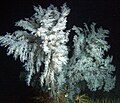Hexacorallia
| Hexacorallia | ||||||||||||
|---|---|---|---|---|---|---|---|---|---|---|---|---|

|
||||||||||||
| Systematics | ||||||||||||
|
||||||||||||
| Scientific name | ||||||||||||
| Hexacorallia | ||||||||||||
| Haeckel , 1866 |
The subclass Hexacorallia , six-rayed flower animals or zoantharia includes almost 4000 of the more than 6000 species of the class of flower animals (Anthozoa) with six orders still alive today .
The relationship can be demonstrated in the young polyp . Because after metamorphosis, the planula larva usually has six tentacles and the stomach space is divided by six longitudinal walls (mesenteries). As the polyp grows, new mesenteries and tentacles are added. In this subclass, there are predominantly colony-forming species. But there are also solitary representatives.
Eight extinct orders, including the Rugosa and the Tabulata , can be found in fossils .
Systematics
The Hexacorallia are one of two subclasses of the flower animals (Anthozoa) and the sister group of the Octocorallia , which are often also called eight-pointed flower animals.
Various studies, based on morphological and molecular comparisons, see the cylinder roses as a basal taxon of the Hexacorallia and as a sister group of all others. The sea anemones are the sister group of an unnamed clade of crust anemones, hard corals, disc anemones and black corals, as well as the Relicanthidae, a monotypical family of sea anemone-like organisms from the deep sea. The phylogenetic position of the extinct orders Rugosa and Tabulata remains unclear.
| Hexacorallia |
|
||||||||||||||||||||||||||||||||||||
|
|
Green giant anemone ( Anthopleura xanthogrammica )
Hard coral
( Acropora palmata )
Individual evidence
- ↑ Estefanía Rodríguez, Marcos S. Barbeitos, Mercer R. Brugler, Louise M. Crowley, Alejandro Grajales, Luciana Gusmão, Verena Häussermann, Abigail Reft, Marymegan Daly. Hidden among Sea Anemones: The First Comprehensive Phylogenetic Reconstruction of the Order Actiniaria (Cnidaria, Anthozoa, Hexacorallia) Reveals a Novel Group of Hexacorals . PLoS ONE, 2014; 9 (5): e96998 DOI: 10.1371 / journal.pone.0096998





